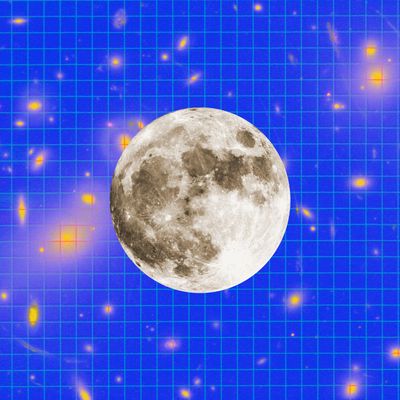
A full moon is obvious. Unless the sky is swamped in smog or cloud cover, it’s impossible to ignore. The moon is the closest celestial object to Earth and has been for billions of years. Made from rock and metal, the moon humbly harmonizes the delicate balance that makes life on Earth possible, shaping our world and — naturally — impacting all living beings on the planet. I.e., the moon’s gravitational pull influences the ocean tides and even stabilizes our planet’s axial tilt, which helps regulate our climate.
But, um, what actually is a full moon? What happens? And what does it mean for you? Read on to find out everything you’ve ever wanted to know about the full moon.
What does the moon symbolize in astrology?
The moon moves through a 29.5-day orbit, changing in shape and size (from our vantage point) as it reflects the sun’s light in varying degrees. Likewise, it takes the moon approximately 28 days to cruise through all 12 signs of the zodiac, remaining in each for about 2.5 days.
From an astrological perspective, the moon is associated with our emotions, sensitivities, and inner world, acting as a mirror to our daily experiences. As the moon shifts from the shadowy stillness of the new moon to the brilliant glow of the full moon, it echoes our own internal transformation.
So why is a full moon special?
Fourteen days after a new moon (which marks the beginning of a new lunar cycle), the sky is electrified by a brilliant full moon. Often referred to as the “climax” of the cycle, this celestial phenomenon occurs when the sun and moon stand directly opposite each other in the sky. During this phase, the moon shines in its full, maximum illumination, casting its boldest and brightest light across the night.
The full moon’s glow has a way of bringing everything into sharp focus, revealing what has been hidden in the darkness. It’s a time when emotions can run high, and unresolved issues come to the surface, demanding attention. Whether you embrace its energy or find it overwhelming, the full moon’s light leaves nothing concealed, urging us to confront what we might otherwise avoid.
Maybe this is why our ancient ancestors feared the full moon — well, that and predators who are more active at night. Wolves, for example, are nocturnal creatures, and their howling is often associated with nighttime, particularly during a full moon when the landscape is radiated by the strange lunar light. This, of course, could explain why wolves — and by extension, werewolves — are linked to this lunar phase. Spooky!
What should I expect during a full moon?
Because the moon represents our emotions, and a full moon is maximum radiance (in other words, maximum emotion), big feelings can take control. Under a full moon, things can feel a little out of control. It’s as if the floodgates open, releasing pent-up energy and intensifying whatever has been bottling up. This surge of emotion can lead to heightened sensitivity, impulsive reactions, or unexpected insights. In a way, the full moon illuminates not just the night sky but also the hidden corners of our psyche, bringing everything to the surface in a powerful, often overwhelming, rush that’s sometimes exhilarating … and other times just exhausting.
The full moon — our emotional mirror — lights up the sky and our minds, so disrupted sleep is a very normal occurrence during a full moon. Restlessness, vivid dreams, or straight-up insomnia are unpleasant consequences of this phase, but the extra nocturnal energy can be excellent for late-night creative musings, candlelit date nights, and profound spiritual breakthroughs.
What should I do during a full moon?
Since people can be extra sensitive and weird during a full moon (werewolves, I tell you!), I’d recommend gentle baths over untamed ragers. Be soft. Don’t go looking for trouble before it finds you. Allow deep dark secrets (or gossip) to reveal themselves without reacting. Really, this is a powerful moment to reflect, release, and clear out anything that no longer aligns with your path.
Typically, new moons are more aligned with manifestation (as in, setting intentions and planting seeds) than full moons, which are best for purging and letting go. This astrologer, however, would like to remind you that releasing is a form of manifesting — we cannot bring new things into our lives without first letting go of what is no longer serving us. Accordingly, a tried-and-true lunar ritual is writing what you would like to release on a piece of paper and ceremoniously discarding it in accordance with the full moon’s element. (Water moons are best for dissolving, fire moons are best for burning, earth moons for burying, and air moons for scattering.)
When is the next full moon?
Full moons occur every 29.5 days, so it’s easy to track these astrological phenomena. Here are the dates for the next six months of full moons (all days Eastern Standard):
- Tuesday, September 17: Full moon (lunar eclipse) in Pisces
- Thursday, October 17: Full moon in Aries
- Friday, November 15: Full moon in Taurus
- Sunday, December 15: Full moon in Gemini
- Monday, January 13: Full moon in Cancer
- Wednesday, February 12: Full moon in Leo
- Friday, March 14: Full moon (Lunar Eclipse) in Virgo
More astrology guides and news
- Behold Your Fall 2024 Horoscopes
- An Introduction to Venus Retrograde
- After Mercury Retrograde Comes Mercury Retroshade





